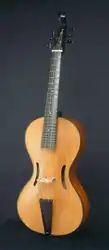Arpeggione
The arpeggione is a six-stringed musical instrument fretted and tuned like a guitar, but bowed like a cello, and thus similar to the bass viola da gamba. The instrument is sometimes also called a guitar violoncello.[1] The body shape of the arpeggione is, however, more similar to a medieval fiddle than either the guitar or the bass viol. It is essentially a bass viol with a guitar-type tuning, E–A–d–g–b–e' . The arpeggione is especially suited to playing runs in thirds, double stops, and arpeggios.[1]
 Arpeggione built in 1968 by Henning Aschauer following specifications of Alfred Lessing. | |
| String instrument | |
|---|---|
| Classification | Bowed string instrument |
| Hornbostel–Sachs classification | 321.322-71 (Composite chordophone sounded by a bow) |
| Developed | 1823 |
| Related instruments | |
It enjoyed a brief period of popularity for perhaps a decade after its invention around 1823, by the Viennese instrument luthiers Johann Georg Stauffer and Peter Teufelsdorfer. The only notable extant piece for the arpeggione is a sonata with piano accompaniment by Franz Schubert, D.821, not published until 1871, when the instrument was long out of vogue. This sonata is now commonly played on the cello or viola, and many other instruments have received transcriptions as well. In the 21st century, a revival of interest in the arpeggione has led to the composition of a number of new works either for the instrument alone or within an ensemble. Composers who have written the largest number of works include the American Dov Joshua Rosenschein,[2] France's Grégory Guéant,[3] and René Mogensen[4] from Denmark.
Contemporary designs of viol-like instruments have similarities to the arpeggione, and at least one (the GuitarViol) was directly influenced by Stauffer's arpeggione.[5][6]
References
- "arpeggione". oxford music online. Retrieved 15 September 2016.
- Dov Joshua Rosenschein holds a degree in composition from New York City's Mannes School of Music and is currently involved in that discipline as a major part of his professional work. Accessed 17 November 2019.
- Grégory Guéant is a French composer and pianist who graduated from the Université de Lille where he currently holds a professorial position.
- Danish-born composer, musician, researcher, producer and educator, René Mogensen holds degrees from the University of Rochester, New York University and the Royal Academy of Music, Aarhus. As a composer, he has built a sound international reputation with a special focus on the combined use of acoustic and electronic or computer-based instrumentation. Currently he is teaching at the Royal Birmingham Conservatoire within the Birmingham City University. Accessed 17 November 2019.
- "History of the GuitarViol". TogaMan GuitarViols. Retrieved November 24, 2017.
- "Our Story". TogaMan GuitarViols. Retrieved November 24, 2017.
- Aquino, F. Avellar de. "Six-Stringed Virtuoso". The Strad Magazine, Harrow, Middlesex, UK, v. 109, n. 1297, p. 500–507, May 1998. About the arpeggione and Schubert's Sonata.
- Geiringer, Karl. "Schubert's Arpeggione Sonata and the 'Super Arpeggione'." "Musical Quarterly", 65, no. 4 (Oct. 1979), pp. 513–523.
- Sadie, Stanley, ed., The New Grove Dictionary of Music and Musicians, vol. 16, 6th. ed., London: Macmillan Press Limited, 1980. s.v. "Schubert, Franz" by Maurice J. E. Brown.
- Schuster, Vincenz. "Anleitung zur Erlernung des . . . neu erfundenen Guitarre-Violoncells". Vienna: Diabelli.
- Tree, Michael, "Schubert’s Arpeggione Sonata". The Strad Magazine, vol. 105, February 1994, p. 142. Master-Class on Schubert's Sonata.
External links
- Nicolas Deletaille's webpage on the arpeggione, a lot of useful information on the arpeggione. (The last fairly trouble-free archive version of this page is at Archive of Nicolas Deletaille's webpage on the arpeggione.)
- Homepage of the "Arpeggione World". Osamu Okumura, Japanese has restored OK-model and Anton Mitteisーmodel of Arpeggione making by himself.
- Photo